Australia tour of Pakistan: Magical tales from 60 years of Aussie tours to a land of eternal mystery
When Steve Waugh snuck out of Australia’s team hotel with Gavin Robertson in Pakistan, they literally stumbled into another world — one with thousands of albinos and underground cities.
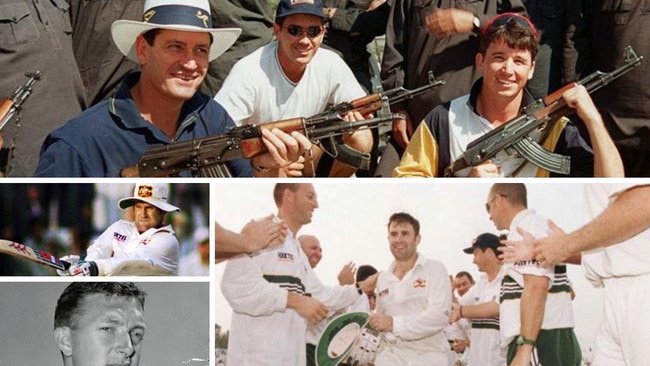
Cricket
Don't miss out on the headlines from Cricket. Followed categories will be added to My News.
Sixty-three years before Marnus Labuschagne prepared for Pakistan on a home-made magic carpet in Brisbane, Richie Benaud was doing the same thing just up the road.
Former Test skipper Benaud heard a whisper the first Test of the first three-match series in Pakistan in 1959-60 would be played on coir matting and not grass, as promised.
The ever-vigilant skipper ordered jute matting to be laid and pulled tight over the turf practice pitches at the Gabba where his team assembled for a Queensland centenary match before leaving for Pakistan.
Watch Australia’s Tour of Pakistan on Kayo. Every Test, ODI and T20 Live & On-Demand. New to Kayo? Start your free trial now >

Just as Labuschagne sharpened his reflexes on a Bunnings mat dotted with pieces of aluminium, the Australians’ three morning mat practice sessions were not wasted as Pakistan did indeed wheel out the coir matting for the first Test in Dhaka (now part of Bangladesh).
The Australians got all-rounder Ken Mackay to practice his “dibbly dobbly’’ off-cutters and leg-cutters on mats at the Gabba and he duly won Australia the match with the incredible figures of 7-58 from 64 overs, including 39 maidens.
“Richie was very clever on that tour,’’ batsman Gavin Stevens told News Corp.
“When it was Australia’s turn to bat the groundsmen would not pull the matting tight and they would throw a few little stones underneath to make it harder for the batsmen.
“So about three or four of us were given the role of going out and watching over them when they were laying the matting. But the tours are so much different now.
“We could not touch the water and the boys used to clean their teeth in Fosters Lager.’’
Stevens will forever be remembered as the batsman who almost perished on the four-month tour of Pakistan and India after becoming violently ill in Madras and never playing first-class cricket again when he returned home.
His brutal experience is immortalised in the book, Near Death In The Sub-continent, but he has no regrets as he prepares for his 90th birthday on Tuesday.
“Life’s been good to me. I’ve been lucky. I have hung in there and had a terrific knock.’’
There will be no coir matting on display this tour, and bottled water aplenty but there is still a tangible and inviting sense of mystery as Australia prepares for its first tour of Pakistan in 24 years.

From 2009-19 all 31 of Pakistan’s Test series were played abroad after it was essentially declared a no-go zone for international cricket when a bus carrying the Sri Lankan cricket team was fired upon by gunmen in Lahore.
In the past three years, Sri Lanka, Bangladesh and Sri Lanka played Test series in Pakistan but Australia’s return is massive boost for the locals as they have the reputation of being the world’s most timid tourists.
If Australia is happy to tour, everyone should be happy to tour.
Some things won’t have changed much in the last 24 years, such as the overwhelming security presence which will make it feel like war zone.
“It wasn’t the safest place in the world to travel back then,’’ said 1998 tourist Colin Miller who made his Test debut bowling seam and spin.
“If you went across the road for dinner there would be three or four army guys and they would stop the traffic when we crossed the road. You’d have a quick meal, bread and ice cream and race back to your hotel. Yet it was still my favourite tour.’’
Back in Benaud’s day it was nigh impossible to get a drink in the non-drinking Muslim nation, though the Australians still managed to get a few hundred cans of Fosters shipped in after requesting an emergency supply of “fruit juice”.
Miller, a night owl who enjoyed the odd tipple, also found it difficult to get a drink until finding a well hidden hotel bar in the last Test when he sampled some local scotch “which tasted like cheese”.
Pakistan remains a land of eternal mystery which many players having stories which are literally part of another world, including …

THE HIDDEN CITY
Australia’s cricketers were under strict instructions from the ACB to not venture outside the hotel when the team arrived in Pakistan for a Test and one-day tour back in 1994.
But the adventurous minds of Steve Waugh and Gavin Robertson did not want to be contained and were determined to enjoy the culture and people of Pakistan.
Unlike the mass security presence forming a ring of steel around Pat Cummins’ Australians this summer, there was nothing stopping Waugh and Robertson sneaking out.
The team arrived in Inzamam-ul-Haq’s home city of Multan for an ODI in October ’94 and as the bus drove into town from the airport, Robertson’s eyes were immediately drawn to the bizarre sight of a shop front with no windows.
“Next day we had nothing on and myself and Tugga went walking, which we weren’t allowed to do, and we headed to that area … and that’s when we saw the shop front – with no glass frontage. It was just dark,” Robertson said.
“We walked in and it got lighter and brighter. The shop had been dug into and suddenly we just felt ourselves walking downwards.
“By this stage we were probably 500 metres down a tunnelled hill and it just opened up into an underground city, rigged up with electricity.
“What blew us away was all of a sudden we’re running into people, and there’s actual shops down there.
“As we got closer we realised these people were all albinos.
“We must have spent two or three hours down there, walking around this underground town with what felt like two or three thousand people.”
Neither Waugh nor Robertson have talked about their incredible experience in the nearly 30 years since.
“We just respected the fact that we shouldn’t have been there and it wasn’t our world to talk about or get involved in,” Robertson said.

THE TUBBY CENTURY
Teammates recall the steely focus of Australia captain Mark Taylor as he slugged his way towards equaling Sir Donald Bradman’s highest score of 334 in the second Test at Peshawar back in 1998.
Normally Taylor would have come back in at session’s end and talk tactics, but in this innings, the determined skipper was in the zone, just trying to rest and get as much fluid back into his body as possible in the oppressive heat.
Many have assumed Taylor’s decision to declare with his score 334 not out was a deliberate decision not to go past The Don, but he has described it as a “quirk of fate”.
Taylor could have easily got one past a fielder late in the day to move to 335 and beyond, but stumps came on day two and ultimately the Australian skipper was motivated by trying to get a result on a flat pitch.
Although he slept less than Steve Smith that night, wrestling with what was the right thing to do.
“I spent hours that night contemplating what to do,” Taylor told cricket.com.au back in 2014.
“I finally got to sleep at about two o’clock in the morning. I was thinking about what to do so I certainly didn’t crash as well as I’d hoped.
“I think ideally I would have batted on for 20 minutes just to put their openers out in the field for 20 more minutes before we declared.
“But I thought if I did that I would then end up on 340 not out or something like that and I think people would have assumed that I’d batted on just for my own glory.
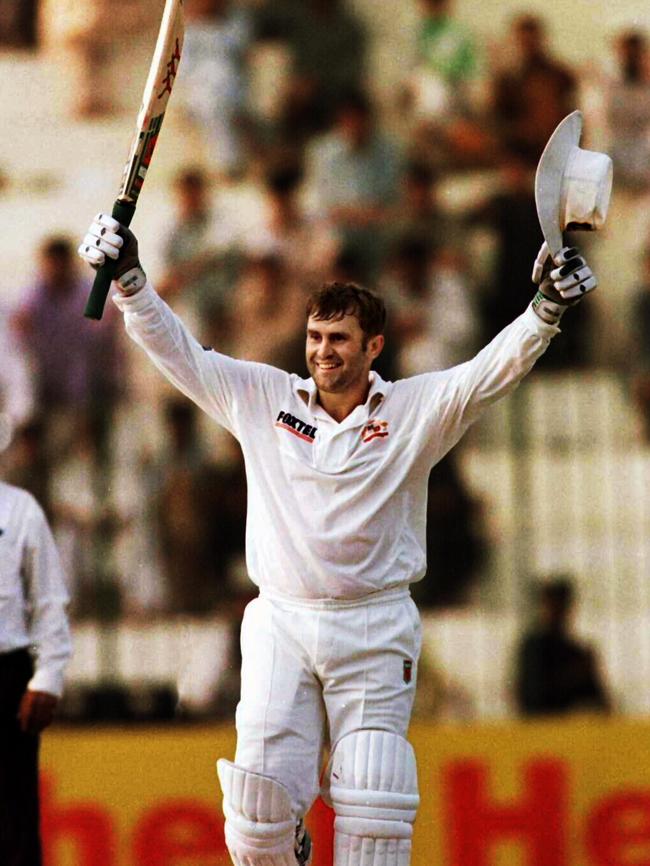
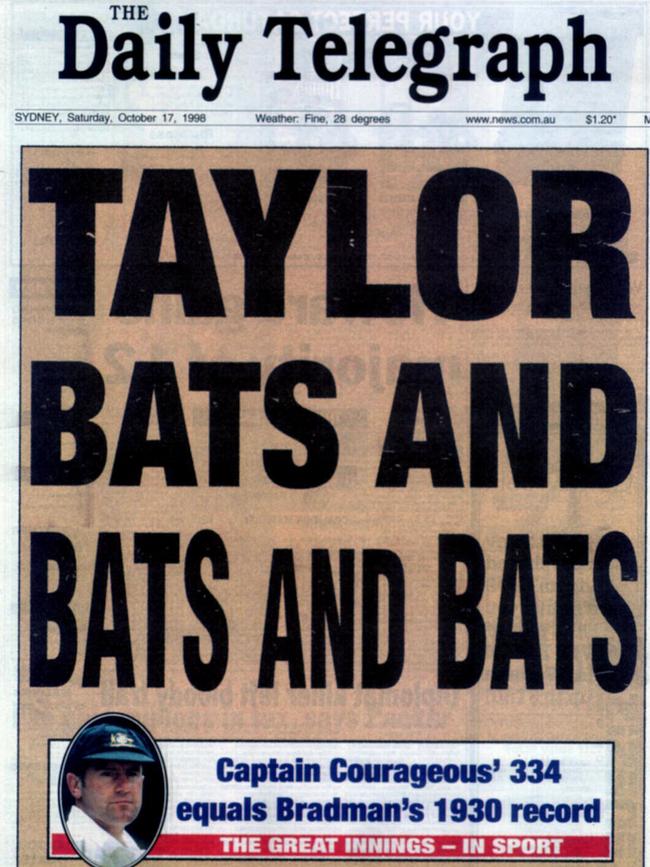
“I didn‘t want to send that message either so the more I thought about it, I came to the decision that the best thing I can do is declare (and) end up on the same score as Sir Donald, which I’m more than delighted with.
“I don‘t want people to think for a minute that I just batted to 334 and said, ‘That’s it, I’m now going to declare’.
“That’s not how it went.
“It was a quirk of fate that I ended up on the same score and I had the chance to work out what I wanted to do.
“I‘ve always said to people that you’re there to try to win games of cricket.”
Bradman wrote Taylor a letter congratulating and thanking him, and the pair met up to discuss the innings.
Robertson was 12th man and after capturing home video footage of Taylor walking off the field undefeated on 334, he remembers taking two bottles of Gatorade to the umpires’ room and coming back with more than he bargained for.
“They changed the ball when he was on about 325 … and (the umpires) gave me the ball and I took it up to his room at quarter past nine that night,” Robertson said.
“I knocked on the door and asked him to sign it for me. And I’ve still got that ball in my bedside table all these years later.”
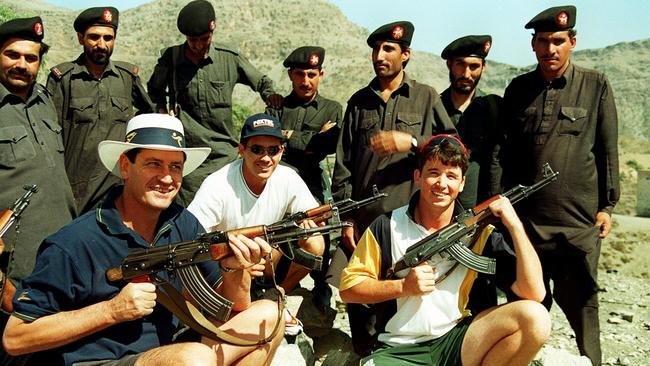
BREAKOUT STORY
Images of Justin Langer and Gavin Robertson holding AK-47 rifles back in 1998 were as innocent as wanting to show respect to the Pakistani border force personnel who had given them a tour of the Khyber Pass.
Team manager Steve Bernard copped a grilling from cricket bosses over the photos taken along the border Pakistan shared with Taliban-led Afghanistan, after they appeared in Australian newspapers the next day.
Robertson says he’s been questioned even more heavily over recent years, when the photos have been circulated on social media, about why the players would have posed like that.
“I’d never shot a gun, but myself and Justin Langer ended up holding the AK-47s. At the time, we thought nothing of that. But in today’s world, it’s astonishing to think … people go, ‘how could you have done that?’” said Robertson.
“Going to the Khyber Pass and meeting these people and listening to how difficult their lives were, you couldn’t do anything but feel very sorry for them.
“They gave us a whole day of their time. They fed us, looked after us, spoke to us about the history and all they wanted was a photo.
“It all seemed very logical because they had to have the guns on them all the time. We did it to show respect to them as people, nothing else was intended.”
Fellow spinner Colin Miller said world renowned Australian tour group leader Luke Sparrow gave him a unique souvenir from that day he still keeps, but admits the timing of the images was unfortunate.
“We got in trouble for that. It was just after the Port Arthur Massacre in Tasmania unfortunately and we were posing with machine guns,” he said.
“I can remember Luke Sparrow collected some of the shells I shot. He took them to a store and got them engraved with ‘Pakistan Tour ‘98 and I still have them.”
Snipers, soldiers, armoured buses: Inside historic Pakistan tour
- Peter Lalor
There will be military, paramilitary and police creating a cordon around the grounds and the hotels. Not in the hundreds but in the thousands.
There will be armoured buses on closed roads. Helicopters and hell to pay if you get in their way. There is a close personal protection team and hostile vehicle mitigation.
Snipers on roof tops and armoured cars on side streets. The Minister of the Interior and Home Departments co-ordinate in Pakistan. Government agencies have assisted in Australia.
Australia’s cricketers face the tightest security and biosecurity bubble they’ve ever encountered when they land in Pakistan ahead of next week’s historic first Test in Rawalpindi.
Wrangling a full-strength Test side for the tour is an incredible achievement given the times.
There for all of March and a week of April — three Tests and a smattering of white-ball confections — no Australian player will, however, set foot on a Pakistan footpath or browse a local market.
Probably the only time they’ll be more than a few metres from a man with a machine gun will be on the field. Even before the times of terror and the attack on the Sri Lankan team bus, before the coronavirus, Pakistan was not a popular place to tour.
The accommodation would challenge a backpacker on a budget, the Tests were played on mats, the food and water a threat to life. The local umpiring legendary.
In 1956, Ian Johnson’s side played Australia’s first Test in Pakistan — it was hardly a compelling affair. The first day saw them produce just 95 runs in what was the slowest day’s Test cricket in history. And still is.
Gil Langley (hepatitis) and Richie Benaud (dengue fever) both became seriously ill on the Indian leg of the tour.

In Gideon Haigh’s brilliant book The Summer Game he tells of the players’ reluctance to return in 1959. At Adelaide Oval that summer Alan Davidson casually asked chairman Don Bradman if the forthcoming tour of India and Pakistan was compulsory.
“You’ve retired, have you?” Bradman replied immediately. Cornered, Davidson said he hadn’t. “That’s good to hear,” Bradman said. “When you get back to the room, you might want to tell them what I’ve just told you.”
Back then Pakistan was a country divided by India, so the first Test was played in Bengal before the team travelled to Lahore for the second. Gavin Stevens became so sick on that tour he never played first-class cricket again.

Nobody was threatened with dire consequences if they didn’t tour this time but it took some time to convince some who were determined it was too unsafe and too difficult.
It helped, however, that the players knew they had not played a Test abroad since the 2019 Ashes, time was ticking away on careers, pressure building on the need to get out there face the world and give back to the game a little of what it has given you.
These days the facilities are five star, the chefs hygienic and creative, the chance of getting ill small and the pitches not covered by mats. Still, Australia has not visited Pakistan since 1998. Other anxieties bedevil the mind.
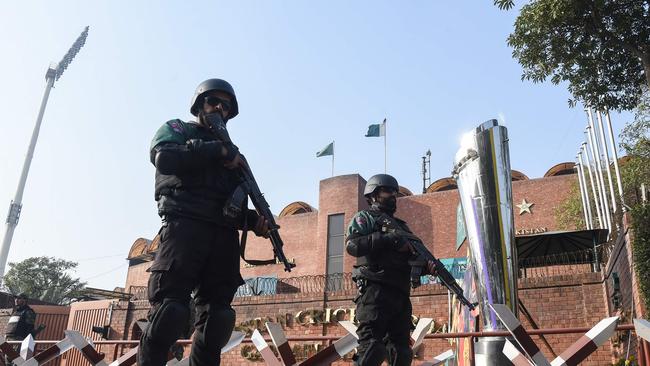

New Zealand fled on the eve of their first ODI match in September.
England refused to even board the plane in October.
Pakistan cricket has been on life support since 2009.
It has had to play its “home” games in the United Arab Emirates, or England or wherever will take it. A generation of fans who are as passionate about the game as any, grew up deprived of international cricket.
The costs of such series were enormous, the returns to the local game pitiful. Nothing in cricket is more soulless than a clash with Pakistan in an empty stadium built in someone else’s desert.
In that decade from 2009-19, all 31 of Pakistan’s Test series were played abroad. In the past three years only Sri Lanka, Bangladesh and South Africa have dared return for Test series.
It has taken some time to lure tentative teams back. The Pakistan Super League offered money to nervous players just to get them to play the final on home soil. Poorer nations were induced to send a side in recent years but the tours have been furtive and fast.
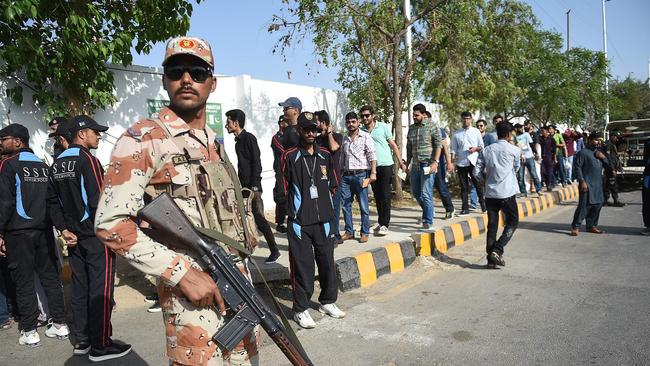
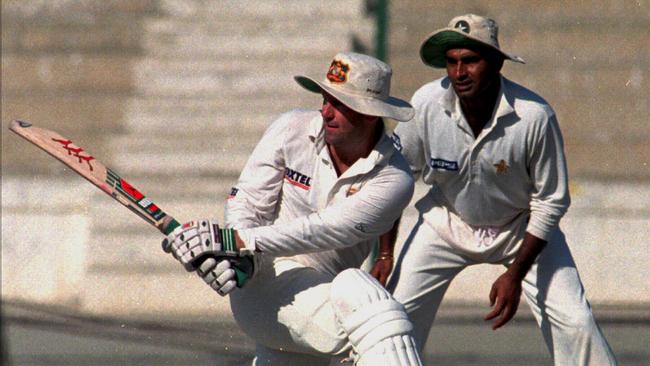
Pulling off the security arrangements for the first return tour in 24 years has taken extraordinary work from Cricket Australia’s head of security Stuart Bailey, his team and counterparts at the Australian Cricketers’ Association. A party flew to watch the security arrangements in action during the West Indies white-ball tour in December and then held a series of meetings with players – some of whom were initially determined not to go.
“Being part of the team arranging this tour has been one of the most important aspects of my career; knowing the impact it will have on world cricket and more importantly what it means to the people of Pakistan,” Bailey told News Corp.
“Having engaged with the Pakistan people in December, I understand the importance of Australia playing cricket there. It is so incredibly important for Pakistan, for world cricket and it’s a historic event for us.
“The security there is as good as you will get anywhere in the world, it is unprecedented for an Australian team and needs to be seen to be appreciated.
“People ask why you need that scale of security if matters are improving in Pakistan and the simple answer is that Pakistan can’t afford to downscale security until all cricketing nations have returned to their country and have a level of confidence.”
The significance, however, of having a Test team of Australia’s stature — one often criticised for not doing its part for international cricket — is enormous for Pakistan and heartening for those who have urged Australia to act in the interests of the broader game.
New CA chair Lachie Henderson understands the significance of the series.
“It’s been such a long absence,” he told News Corp.
“Whilst we’ve had some Australia A and under-19 tours this is a huge return for us. I think it’s really important Australia plays its role internationally and not just locally.
“The fact we have a full strength squad is an endorsement of the tour and the preparation that has gone in to getting back to Pakistan.”
The Australians believe the security is as good as you get anywhere in the world and probably the best. The sight of machine guns and helicopters and cordons can be as unsettling as it is reassuring but the Australian security detail say the reason there is so much caution is obvious: should anything happen it will be back to square one for Pakistan.
Another decade without international cricket is too awful a thought to consider, to grave a prospect to risk, so millions and millions are being spent to ensure this tour goes off without a hiccup.




